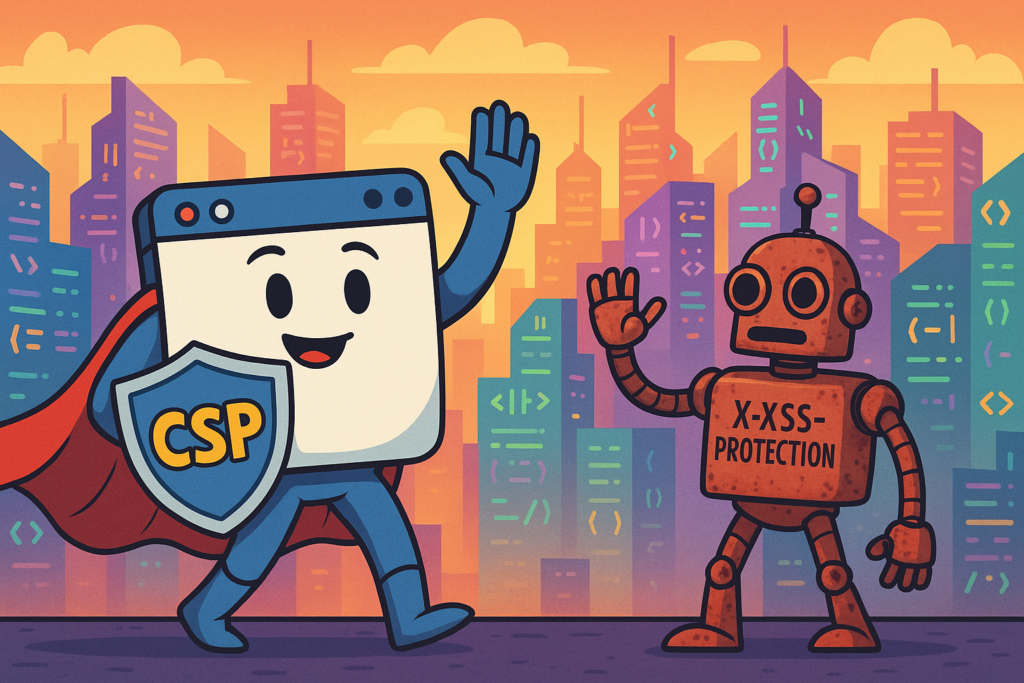🧠 TL;DR: X-XSS-Protection is deprecated and potentially harmful. Major browsers have removed or never supported it due to flaws and bypasses. In 2025, it’s best to disable it explicitly and use Content-Security-Policy (CSP) instead for real protection.
Table of Contents
How I Realised X-XSS-Protection Was Useless
Like many developers, I used to add this header by default:
X-XSS-Protection: 1; mode=block
It felt like a good idea. Free XSS protection, right? But over time, I saw unexpected issues:
- Forms broke in Chrome without clear error messages.
- Some pages mysteriously refused to load.
- Security scanners still flagged my site.
After digging into docs and browser changelogs, I realized: this header is a relic.
What Is X-XSS-Protection?
It was introduced in IE8 (2008) to activate the browser’s built-in reflected XSS filter. It had several modes:
X-XSS-Protection: 1; mode=block
1: Enable filtering1; mode=block: Block the entire page on XSS detection0: Disable filtering
This seemed helpful at the time, but the web evolved.
Why Browsers Dropped It
1. Bypass-able Filters
Attackers could trick the filter using encoded characters, unbalanced quotes, or script attributes.
2. False Positives
Legit content containing <script> or certain keywords got blocked.
3. Cross-Site Leaks (XS-Leaks)
The filter introduced side-channel vulnerabilities, leaking sensitive data.
4. Inconsistent Behavior
- Chrome removed support in v78 (2019)
- Firefox never supported it
- Safari deprecated it by 2023
- Edge followed Chrome
Today, only Internet Explorer still honors it—and IE is itself deprecated.
Real Problems I Faced
- Debugging mysterious block pages with no console error
- Unexpected behavior in Chrome v77 when CSP and X-XSS-Protection were used together
- User reports of “broken forms” traced back to input filters
These weren’t security issues. They were caused by the header that was supposed to protect me.
What to Do Instead: Disable It Explicitly
You shouldn’t just remove it. Older browsers may still act on it. Disable it deliberately:
X-XSS-Protection: 0
This avoids broken filtering in outdated environments.
How to Disable X-XSS-Protection (All Platforms)
NGINX
add_header X-XSS-Protection "0" always;
Apache
Header set X-XSS-Protection "0"
Express (Node.js)
app.use((req, res, next) => {
res.setHeader("X-XSS-Protection", "0");
next();
});
PHP
header("X-XSS-Protection: 0");
Cloudflare / CDNs
Add via dashboard:
- Header:
X-XSS-Protection - Value:
0
What Replaces X-XSS-Protection?
There is no direct replacement, but the modern, recommended approach is:
Use Content-Security-Policy (CSP)
CSP is a powerful header that tells browsers what is allowed to run on your page. It can prevent XSS entirely.
Example:
Content-Security-Policy: script-src 'self';
This blocks inline scripts and prevents injection attacks.
With Nonces:
Content-Security-Policy: script-src 'self' 'nonce-r4nd0m';
And your script:
<script nonce="r4nd0m">console.log("Safe script")</script>
Only scripts with the right nonce will run.
CSP vs. X-XSS-Protection (Quick Comparison)
| Feature | X-XSS-Protection | Content-Security-Policy |
|---|---|---|
| Stops Reflected XSS | Sometimes | Yes |
| Stops Stored XSS | No | Yes |
| Modern Support | Deprecated | Fully Supported |
| Configurable | No | Yes |
Tools to Test Your Headers
- SecurityHeaders.com
curl -I https://yourdomain.com- DevTools > Network > Response Headers
Check for:
X-XSS-Protection: 1; mode=block
If you see it, time to clean it up.
Final Advice
| Do This | Not This |
|---|---|
X-XSS-Protection: 0 | 1; mode=block |
| Use CSP | Rely on browser filters |
| Validate + Encode Inputs | Assume headers will save you |
🧐 FAQ
Q: Can I just remove the header?
A: Set it to 0 instead. This ensures even IE or legacy apps don’t activate unsafe behavior.
Q: Is CSP really better?
A: Yes. CSP actively prevents script injection, not just reacts to it.
Q: Will scanners complain if I remove X-XSS-Protection?
A: Only outdated ones. Modern scanners expect you to disable it.
